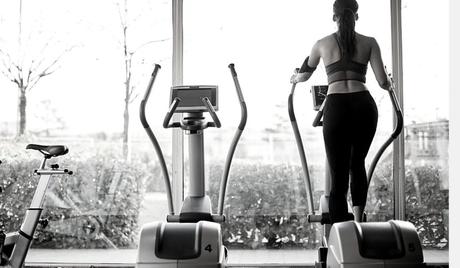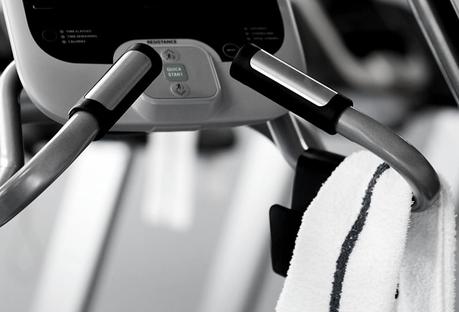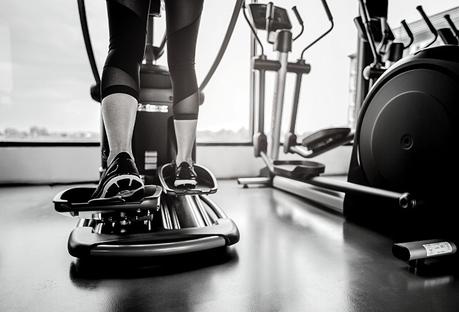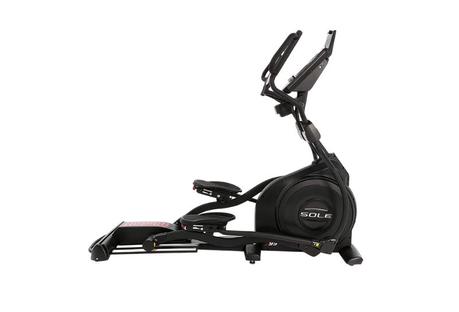Numb feet on the elliptical can be a real pain in the butt and can cut short a good workout. Here are the primary causes of foot numbness on the elliptical and how to fix it.

We’ve all encountered it before: we’re pedaling away on our elliptical, putting in the work, but slowly our feet start to go numb until we can’t really feel our legs anymore.
It’s not just uncomfortable and annoying; it can actually be dangerous!
In this article, we’re going to talk about why your feet might be going numb on the elliptical trainer, what you might be doing to cause it, and what you can do to make sure it doesn’t happen.
At the end, we’ll include a few recommendations of elliptical machines designed specifically to reduce foot numbness and make every workout more comfortable.
Causes of Foot Numbness on the Elliptical
As you know, there are a lot of benefits of elliptical trainers.
We’ve listed them in many of our previous articles on this site, but my personal favorites are:
- More calories burned on the elliptical machine than most other cardio machines
- Low-impact, high-efficiency exercise
- Full-body muscle and cardio training
- Highly effective for improving balance
- Great for building glutes on the elliptical
All pretty solid “pros”, right?
But, as with all machines, there are a “con” or two to be aware of. One of the most common cons with the elliptical (and machines like treadmills and stationary bikes, too) is foot numbness.
There are a number of things that may be causing your foot to go numb while on the elliptical:
Pressure On Your Nerve
This is the most likely cause of foot numbness, also called “parasthesia”. When you pedal, you place lot of pressure on the balls of your feet and your toes.
Over time, this pressure can constrict the nerves and even reduce circulation to the point where your feet go numb. The longer you pedal, the more likely your feet are to go numb due to this pressure.
The fact that you keep your feet flat during the elliptical training can also be a contributing factor. When you run, you lift your feet between each step, so the pressure on your feet is reduced for the split second it’s in the air.
But because you’re not lifting your feet on the elliptical, there is a build-up of pressure that doesn’t get released unless you consciously shift your posture.

Improperly-Fitting Shoes
If you wear shoes that are too tight, they can place pressure on your feet, which in turn can reduce blood flow to your feet.
Shoes that are too loose may also be at fault, though, because you have to lace them up very tightly in order to keep them from slipping off your feet, and that too-tight lacing can impair circulation.
Incorrect Stance and Posture
People who slouch or hunch find that their circulation decreases, and poor posture can even reduce activity in the central nervous system, increasing the risk of foot numbness.
Poor stance on the elliptical can also impair the proper flow of blood to your feet, apply pressure on your nerves, and, of course, place strain on your joints and muscles.
Poor Circulation
People with poor circulation (due to other causes) may find that their feet tend to go numb when running, cycling, or pedaling on the elliptical even if they use the proper form or posture.
Anyone with poor circulation should be highly aware of how tight their laces are tied and consider wearing compression socks to aid in circulation.
Underlying Medical Condition
There are a number of underlying medical conditions that may contribute to foot numbness, including plantar fasciitis, diabetes, and fibromyalgia. These aren’t all guaranteed to cause foot numbness, but could make it more likely.
It’s important to understand what may be the cause behind your foot numbness so you can know how to correct the problem.
Next, we’ll offer simple solutions to help you fix numb feet on the elliptical.
How to Fix Numb Feet on the Elliptical Trainer
If you find that your feet often go numb, here are a few solutions that will help you to correct the problems that could be causing the numbness:
Improve Your Stride and Posture
If you’re feeling a lot of numbness in your feet, it could be because of the way you’re standing or walking.
Start off by correcting your posture on the elliptical. Stand with your head up, shoulders back, spine upright, hips aligned with your back, core tight, and knees over your toes.
Improving your posture can do wonders to not only help improve circulation, but also increase function of your central nervous system.
Once you know you’re standing right, pay attention to your stride. Keep your knees soft with every step, and make sure they track straight forward and backward over your toes, not flaring out to the side.
Try to mimic the natural pressure on your heels and toes that you’d experience if you were walking normally.
Occasionally, lift your feet off the pedals for a few steps. That will reduce the pressure on your toes and the balls of your feet, allowing for better circulation and nerve function.

Walk Backward
It may sound silly, but it really works! Going backwards on an elliptical trainer is an amazing way to target your quads, but it can also change the way pressure is distributed across your feet with every step.
Instead of transitioning from your heel to your toe, it will almost feel like the transition in reverse (toe to heel), and it will give your feet a break. Try pedaling backward for 5 to 10 minutes to restore full circulation.
However, be aware that pedaling backward long-term can also cause your feet to go numb, because though the pressure points change, there will be pressure nonetheless. Reverse directions every 15 to 30 minutes.
Experiment With Shoe Sizes
Shoes that are too small can be just as bad for your foot numbness as shoes that are too large.
You may find that shoes that fit you “just right” on the gym floor will be just a tiny bit too small when on the elliptical because of the way your feet swell slightly when walking or standing upright for long periods of time.
Try experimenting with a couple of different pairs of shoes—and styles of shoes—to find what suits you best while on the elliptical.
Change the Incline
We all know that changing the incline is one of the best means of building glutes on the elliptical. The steeper the incline, the more your glute muscles have to engage to push your body upward with every step.
However, changing the incline can also give you a chance to lift your feet off the pedal with each step (or every other step). This can help to decrease the pressure on your feet and allow for better circulation.
Shorten Your Workout
A longer workout may burn more calories, but it’s also more likely to cause foot numbness. After all, every step increases the pressure on your feet and toes, affects your circulation, and increases the risk of swelling.
If you find that you start to get numb over the course of a longer workout (45 to 60 minutes), try switching things up and shortening your workout. Do a shorter elliptical workout and spend the rest of the time on another machine—such as the rowing machine—that won’t place so much pressure on your feet.
Or, go for a HIIT workout, mixing high-intensity intervals of fast-paced pedaling with slower, low-intensity pedaling intervals.
An elliptical trainer HIIT workout can actually burn more calories than a steady-state, low intensity workout, and in a fraction of the time—just 15 to 25 minutes, instead of 45 to 60. It’s a great way to prevent the foot numbness and discomfort so common to elliptical workouts.
Do Not “Push Through”
Whatever you do, DO NOT try to “push through” the foot numbness and keep working out. The longer the numbness persists, the more likely it will impair your circulation or impact your central nervous system.
Plus, there is always the risk of the numbness spreading up your legs, which could make it harder to maintain your balance and continue working out safely.
If you feel the numbness starting to set in, try all the tricks and tips listed above. If none of those work, step off the elliptical and walk around on flat ground for a few minutes until the circulation normalizes and feeling returns fully to your feet.
Only then should you resume your elliptical workout.
What Elliptical Machines Can Help Reduce Foot Numbness?
Did you know that some elliptical machines are actually designed specifically to reduce foot numbness?
They come with specially designed foot pedals that encourage a more natural gait, as well as preventing the build-up of pressure in your toes.
Here are a few models to consider:

Sole Fitness E95 – This model is Sole Fitness’ highest-end offering, with the heaviest flywheel, whisper-quiet drive, and a wide range of pre-programmed workouts. But what makes it so useful specifically for you is the design of the pedals, which are set to a specific angle that helps to smooth out your stride and decreases the pressure on your forefoot, thus preventing foot numbness.
Sole Fitness E25 – This Sole Fitness elliptical is one of their budget-friendly models, a mid-tier machine that offers many of the high-tech features of the upper-end models but sells at a more accessible price. It, too, has the specially designed pedals that will reduce pressure on your feet and encourage a more natural gait. (For more information on Sole ellipticals, check out this detailed comparison of Sole ellipticals.)
ProForm Carbon HIIT H7 – This machine is designed to be adjusted to a steep incline, which makes it nearly as effective for a glute-focused workout as a stair-climber. Because of this, it’s easy to lift your feet off the pedals with every step, which will decrease pressure and help to improve circulation. Plus, it’s compact enough to fit in virtually any home gym.
Teeter FreeStep LT3 Recumbent Cross Trainer and Elliptical – This is a recumbent elliptical, meaning you sit in it rather than stand on it. There is still some risk of foot numbness—after all, you’re working the pedals just like you would with a regular elliptical machine—but it’s easier to lift your feet and adjust your foot placement if you feel the pressure increasing. Plus, there’s less direct pressure on your feet and it improves circulation.
These are great machines to consider if you’ve got a problem with frequent foot numbness and watch a solution designed specifically to combat it.
The Bottom Line
How you use the machine won’t just affect the quality of your workout, but your comfort during that workout.
If you have the proper stance and form, move smoothly, change directions, and adjust the incline, you’ll find it’s a lot easier to combat foot numbness and make your workout a whole lot easier to get through pain- and discomfort-free!
More Elliptical Guides Like This
How Much Do Ellipticals Cost? (44 Different Models Compared). Ellipticals can be a costly investment in your workout goals. Here is a look at how much each type of elliptical costs and how much to spend on one.
Elliptical Buying Guide – Everything You Need to Know to Buy with Confidence. Want to buy an elliptical but don’t know where to start? Arm yourself with the knowledge to choose the perfect elliptical for you and your workout goals.
